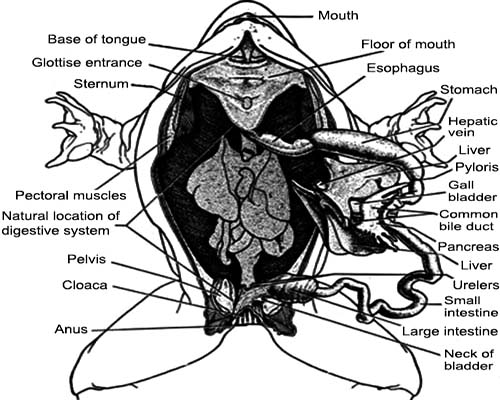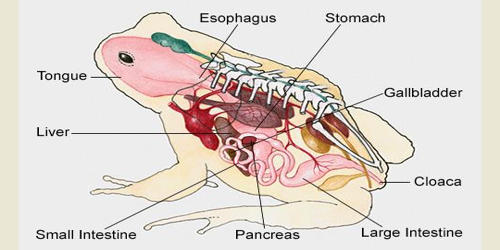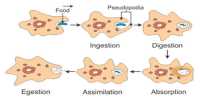Nutrition System of Toad
Intake of food, digestion of food, absorption of digested food materials, and elimination of undigested waste materials are included in nutrition.
Toad is a carnivorous animal. The main food of toad is live worms, insects, earthworms, snails, etc. With the sticky tongue, it catches the prey and swallows it. Like all vertebrate animals, in the food of toad protein, carbohydrate, fat, salt, vitamins, and water components are present. These six types of components can be obtained from the bodies of worms and insects. It is not required to digest salt, vitamins, and water.
The cells of the body of toad can directly absorb these three types of food. But protein, carbohydrate, and fat are complex organic substances; hence the body cells cannot absorb them directly. In the presence of enzymes, these insoluble, complex, and non-absorbable food substances take part in organic chemical reactions and transform into simple and absorbable liquid components. These changes in food substances are called digestion.
After the intake of the food, there are no chemical changes inside the buccal cavity. The food substances become slippery by the mucus secreted from the walls of the buccal cavity. Food substances reach the stomach through the oesophagus where digestion begins.

Digestion System of Toad
The toad lives on worms, insects, etc. The system which takes part to perform this work is called the digestive system. The digestive system of the toad can be divided into two parts such as the Alimentary canal and Digestive glands.
(a) Alimentary Canal: The canal extended from, the mouth opening to the cloacal aperture is called the alimentary canal or gut.
(i) Mouth: At the front end of the body of the toad the mouth or mouth opening is situated. The mouth of the toad is quite wide and semicircular.
(ii) Buccal cavity: Behind the mouth opening the wide buccal cavity is situated. On the lower side of the buccal cavity lies the wide muscular tongue.
(iii) Pharynx: The narrow extended part of the gut between the buccal cavity and oesophagus is the pharynx.
(iv) Oesophagus: The stout, short, and canal-like part next to the pharynx is the oesophagus. Through the oesophagus, food substances reach the stomach.
(v) Stomach: Behind the oesophagus the curved sac-like part is the stomach. Its wall is thick, muscular, and glandular. The glands remain within the inner surface of the wall. The stomach is divided into parts, cardiac and pyloric part.
(vi) Intestine: The coiled duct extended from behind the stomach up to the cloacal aperture is the intestine. The intestine is divided into two parts, Small intestine, and Large intestine.
- Small intestine: The narrow, coiled anterior part of the intestine behind the stomach is the small intestine.
- Large intestine: Posterior to the small intestine, the comparatively thick part is the large intestine. It is divided into two parts, rectum and cloaca.
(b) Digestive glands: The glands which secrete digestive juices and digestion and helps in the digestive process are called the digestive glands. Toads have two main digestive glands, Liver and Pancreas.
Liver: The liver is the largest gland of the body, located on either side of the heart. This gland is divided into two parts, right and left, which are connected together by a middle part. The functions of the liver are
- Liver stores glycogen, fat, and vitamins. It is called the storehouse of the body.
- It assists in protein synthesis.
- Red blood corpuscles originate in the liver.
Pancreas: Pancreas is a very important digestive gland of the vertebrate animals. This gland is situated in between the stomach and duodenum.
Digestion in the stomach: Inner walls of the stomach are glandular. After the food substances reach the stomach a hormone is secreted from its walls. This hormone is called gastrin. By the influence of gastrin, digestive juice is secreted from the gastric glands.
Digestion in the duodenum: When the chyme reaches the duodenum from the stomach, it comes in contact with the bile, secreted from the liver, and pancreatic juice from the pancreas. Bile converts the fat food into smaller droplets and makes it suitable for reaction with the enzyme.














